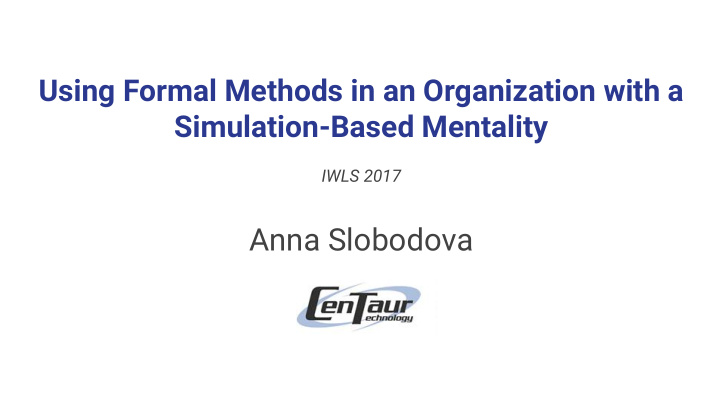



Using Formal Methods in an Organization with a Simulation-Based Mentality IWLS 2017 Anna Slobodova
Formal Verification Team Shilpi Goel Anna Slobodova Rob Sumners Sol Swords
Centaur Technology Founded in 1995 as a startup to lower cost of x86 processors 100 people; constant for over ten years
About Us ● Focus on low power, low cost, and high performance x86 processors Parts are sold as products of VIA ● Technologies / Zhaoxin ● 15 major designs shipped Customers: IBM, Dell, Samsung, ● HP, Lenovo
Challenges of x86 Design and Validation ● Target is x86 instruction-set architecture. A very low-level of x86 ISA compatibility required. ○ ○ x86 ISA is complicated, under-specified, & evolving. In early days, we were burnt making some “who would ever care about that” ● assumptions: ○ Undefined flags Undefined A20 “interrupt” handling ○ ○ Undefined uncacheable fetch behavior Hidden processor memory areas ○ ○ Reserved bit exceptions Model-specific registers usage ○ ● There are many versions of the implementation.
Reasons to Consider FV at Centaur ● Testing cannot cover increasing number of instructions and widening operands
Early Formal Verification Projects at Centaur ● Started by Warren A. Hunt, Jr., Bob Boyer, and Sol Swords in 2007 Does a sequence of micro-operations implement the 64-bit integer divide? ● ○ Yes. FV found no bugs here. ● Does a new and fast FP addition implementation meet its specification? FV introduced late in design cycle after thorough testing was done. ○ Corner case found --- ~1 in 2 144 chance! ○ … this narrowly defined error may have Tom Elmer otherwise remained Designer undetected through tape out. ● Bugs found late in the design showed shortcomings of EDA vendors’ transistor-level design validation tools ○ FV team created a formal model of the transistor-level design for equivalence checking
Centaur Formal Verification Tools Today Based on ● First FV effort at Centaur was successful ● Publicly available Rich ACL2 libraries ● ● In use/development for 25+ years Flexible for building point and ● general-purpose tools ACL2 developers, interns, and future ● employees in town!
FV Tool Flow at Centaur ● From SystemVerilog RTL and Specifications to ACL2 Proofs:
Where FV Can Help #1 Specifying and verifying data-intensive arithmetic and logic operations 64- to 512-bit wide integer and floating-point arithmetic and logical operations ● ○ Increase in number of cases due to write-masking ○ The Media Integer Unit executes over 470 MMX, SSE, and AVX instructions, not counting the various forms of each instruction. ...I have implemented the MINT unit for several projects without a single bug in silicon. I feel that formal verification has been a key factor in this happy story. Tom Glover Designer
Where FV Can Help #2 Verification of self-contained microcode blocks E.g.: 64-bit integer multiply, 64-bit integer divide, SSE 4.2 string compare instructions, etc.
Where FV Can Help #3 Maintaining correctness across different design versions ● Re-running proof regressions whenever design is modified ○ Design is growing to cover more functionality Design is changing in the design exploration phase ○ ○ Design is being optimized due to timing/power considerations Checking the correctness of bug fixes ● … when the bug was fixed, formal verification quickly demonstrated correctness, rather than having to directly create and analyze exhaustive test vectors. Tom Elmer Designer ● Fast rerun of proofs allows late design changes
Where FV Can Help #4 Verifying memory operations NEW! ● Goal: prove MP memory operations always complete with legal results. Communication ring routes requests, responses, credits, etc. between ● endpoints (Cores, LLCs, IO, DRAM). ● Current focus: Prove all operations make progress to completion in L2+LLC+Ring. Formal approaches to searching for deadlocks, starvation bugs, and credit leaks will be important tools… for verifying our memory Doug Reed hierarchy going forward. Designer
Where FV Can Help #5 Having a formal model of the RTL design allows various kinds of analyses: ● Static checking: e.g., linting Functional ● Structural ● ● Control- and Data-Flow ● Dependency
Where FV Can Help #6 ● Checking design-specific (internal) properties on demand ● Equivalence of different versions of the design ● Verification of new algorithms for instruction implementation ○ E.g., Fused Multiply-Add ● Assistance with late changes in design (ECO) ● Mechanically-generated web-based documentation of ISA and microarchitecture-level behavior and the proofs’ status ● Map post-synthesis signals to RTL design signals to interpret timing reports ● Expand test database for DV validation of floating-point instructions
Where FV Probably Can’t Help ● When specification is as complex as the design ○ Specifying and verifying the processor front-end: does a sequence of ISA-level instructions translate “correctly” to a sequence of micro-operations? ● Compatibility with Intel machines in under-specified and/or ambiguous features E.g.: legacy modes, model-specific registers, CPUID-specific behavior, etc. ○ ● When the design interface is not “clean” Low-level functionality (e.g., power management) ● ● Interplay of microcode and hardware
Questions?
Recommend
More recommend